First, a quarter of regulations on the operation of the enterprise economy
In the first quarter of 2017, the knitting industry has a good operating posture, and the liquidity of production and sales of enterprises has increased; the growth of domestic sales has driven the adjustment of the industry market and product structure; the profitability of the industry has improved, the use of funds has been good, but the cost has continued to increase; Accelerate, especially the bottoming out of knitwear investment, driving the rapid growth of industry investment.
1. Main income and growth rate
In the first quarter of 2017, the growth rate of enterprises in the knitting industry regulations has obviously rebounded. 5748 households completed the main business income of 165.183 billion yuan, a year-on-year increase of 9.10%, an increase of 2.94 percentage points over the same period of last year (2016 knitting industry completed the main business income of 754.515 billion yuan); the company's main business income accounted for the textile industry The 9.85% of the enterprises on the regulation were basically the same as the same period last year. Among them, knitted fabrics to enhance the rapid growth in the first quarter year on year growth rate increased to 11.40 percent, over last year increased 6.02 percentage points; in the first quarter year on year growth of knitted garments rose 7.44%, a slight increase over last year 0.70 percentage points.
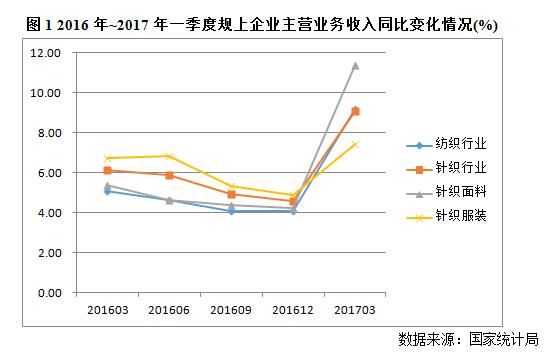
2. Production and stocks
In the first quarter of 2017, the knitting fabrics produced 3.223 billion pieces of knitted garments, an increase of 2.01% year-on-year. The growth rate was 3.82 percentage points higher than that of the same period of last year (2016 knitting fabrics produced 14.427 billion pieces of knitted garments). In terms of finished goods inventory, the knitting industry has an inventory of finished products of RMB 26.994 billion, an increase of 5.77% year-on-year, an increase of 3.26 percentage points over the same period of last year, an increase of 1.56 percentage points over the previous year, and an increase in corporate inventories; accounts receivable and The ratio of the two funds to finished products accounted for 38.50% of the current capital ratio (referred to as the ratio of the two funds), which was 0.11 percentage points lower than that of the same period of last year and 1.4 percentage points lower than that of the whole year of last year. The liquidity of production and sales of enterprises has increased. Among them, the finished goods inventory of knitted fabrics increased by 8.79% year-on-year, up 10.09 percentage points over the same period of last year. The proportion of two funds occupied was 37.65%, which was 0.53 percentage points lower than that of the same period of last year. The inventory of finished garments of knitted garments increased by 3.45% year-on-year. The decrease was 2.30 percentage points, and the proportion of the two funds was 39.19%, an increase of 0.24 percentage points over the same period of last year.
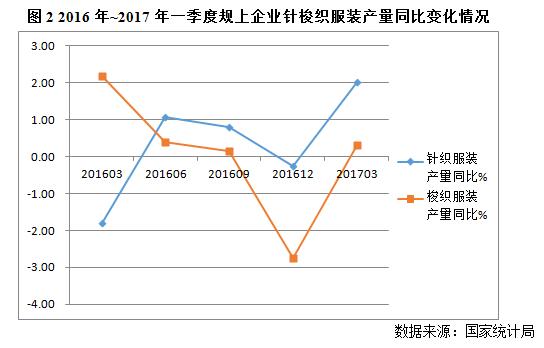
3. Internal and external sales
2017 a quarter of the knitting industry export delivery value of 38.281 billion yuan, an increase of 2.30% over last year increased by 0.6 percentage points (2016 knitting industry export delivery value of 193.164 billion yuan); the proportion of domestic sales to continue to increase from a year earlier And 75.83% and 74.40% of the whole year last year increased to 76.83%. Specifically, domestic and foreign sales have become different in the growth of knitted fabrics and knitted garments. Last year, the export market of knitted fabrics was sluggish and sustained negative growth. In the first quarter of 2017, the growth rate of export value of knitted fabrics showed a significant warming, up 8.02% year-on-year. Domestic sales also showed a growth rate of 12.02% year-on-year, which was higher than that of the same period of last year. The domestic sales ratio increased from 84.57% and 83.63% in the same period of last year and 85.83% to 85.03%. At the same time, domestic sales were more obvious for knitwear. In the first quarter, the export of knitted garments on the knitting regulations remained sluggish, with a slight increase of 0.27% year-on-year, while domestic sales increased by 10.72% year-on-year, an increase of 2.24 percentage points over the same period of last year. The domestic sales ratio was 68.36% and 67.27 of the same period last year and the whole year. % increased to 70.70%. The growth of domestic sales has obvious effects on the industry. It has a greater relationship with the increase in supply-side structural reforms and the stabilization of the domestic economy. To adapt to market changes, enterprises need to constantly adjust the market and product structure.
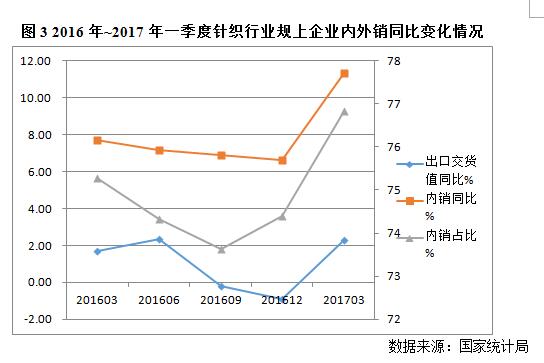
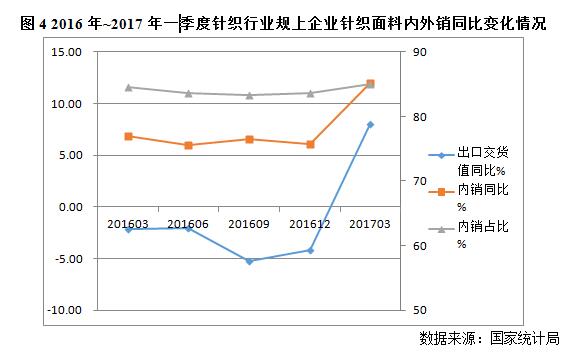
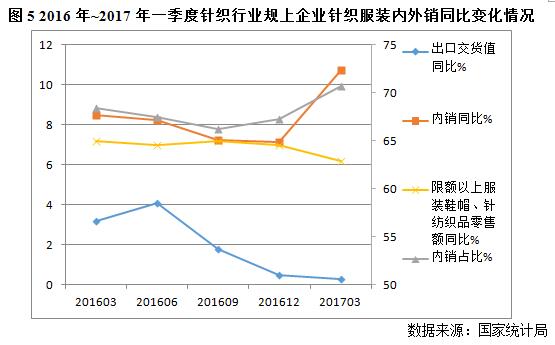
4, running quality
(1) Profitability
In the first quarter of 2017, the knitting industry showed signs of better recovery and the industry's profitability improved significantly. Total profit increased by 12.47% year-on-year, 1.45% compared with the first quarter of last year; industry losses have narrowed, loss of loss-making enterprises decreased by 4.87% year-on-year, 6.73 percentage points lower than the first quarter of last year, but the loss was expanded compared with last year. The loss was 18.77%, a decrease of 2.17 percentage points compared with the same period of last year, but it was 8.15 percentage points higher than that of the whole year of last year. The industry showed obvious polarization. The industry profit rate has improved compared with the first quarter of last year, but compared with last year. It has been reduced throughout the year.
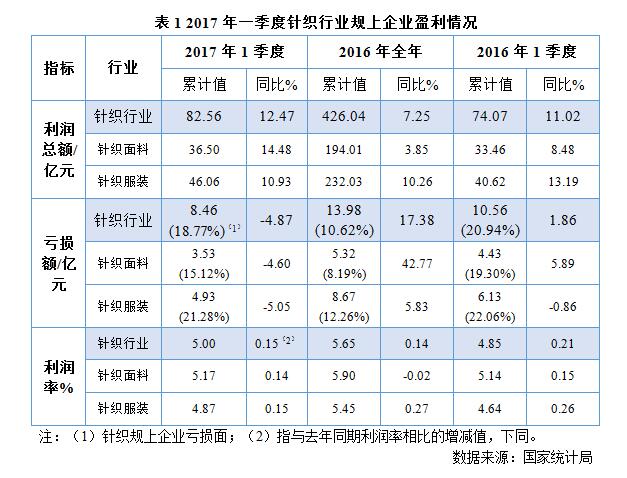
(2) Cost and expense
In the first quarter of 2017, the gross profit margin of the knitting industry regulations decreased year-on-year, which is consistent with the phenomenon that the industry profit rate in the first quarter was lower than that of the previous year, indicating that the growth rate of the main business cost is greater than the growth rate of the main business income of the industry, and the operating cost of the industry. There is a significant improvement. Among them, the gross profit margin of the knitted fabrics in the first quarter decreased by 0.19 percentage points compared with the same period of last year, and the operating cost increased; the gross profit margin of the knitting apparel regulations was the same as that of the same period of last year. In the first quarter, the proportion of the three expenses in the knitting industry was 7.15%, a slight decrease of 0.17 percentage points year-on-year, but an increase of 0.35 percentage points over the previous year, indicating that the sales, management, and financial expenses of the company have increased, and with raw materials, labor, and equipment. As the cost of the processing continues to increase, the operating costs of the industry will continue to increase.
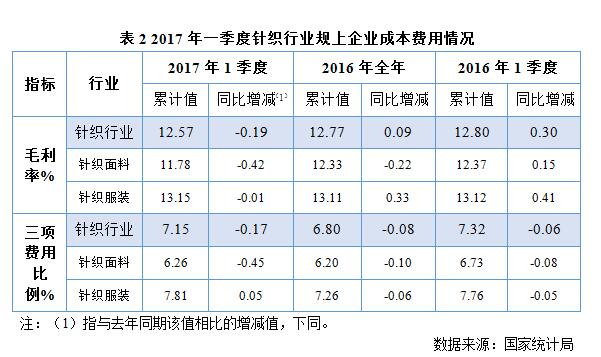
(3) Capital use efficiency
In the first quarter, the asset-liability ratio of the knitting industry was reduced by 1.08 percentage points compared with the same period of last year, which was 0.58 percentage points higher than that of the previous year. The overall debt ratio did not change much. The debt ratio of knitted fabrics was higher than that of knitted garments. In the first quarter, the total asset turnover rate (annualization) of the knitting industry was 1.45 times, 0.03 times higher than the same period of last year, and the turnover rate of finished products (annualized) was 24.48 times, which was 0.75 times higher than the same period of last year. Both indicators were higher than the same period of last year. The use of industry funds in the first quarter was better than the same period last year.
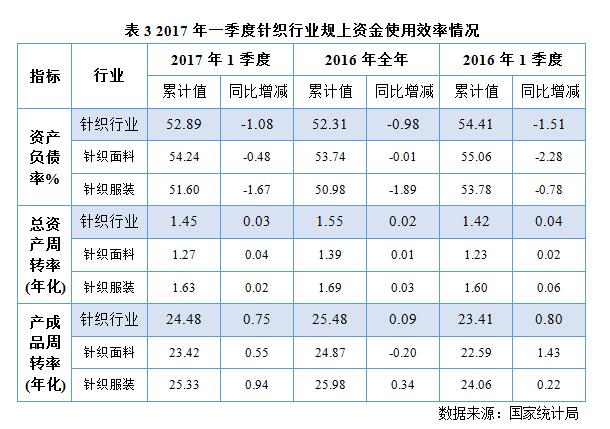
5. Investment situation
In the first quarter of 2017, the actual investment in the knitting industry regulations was 21.250 billion yuan, a year-on-year increase of 18.55%, an increase of 14.35 compared with the same period of last year (2016, the knitting industry regulations completed the investment of 125.852 billion yuan), accounting for 9.96% of the textile industry investment. The proportion increased by 1.12 percentage points in the same period last year. Among them, the growth rate of knitted garment investment bottomed out. In the first quarter of 2017, the investment was 11.986 billion yuan (completed 67.162 billion yuan in 2016), an increase of 26.70% year-on-year. The growth rate was 25.9 percentage points higher than that of the same period of last year, which accounted for the knitting industry. 56.40% of the investment, the proportion increased further; knitted fabrics completed an investment of 9.264 billion yuan (completed 58.69 billion yuan in 2016), an increase of 9.45% year-on-year, an increase of 2.14 percentage points over the same period last year. The investment in the knitting industry, especially knitwear, has driven investment growth in the textile industry.
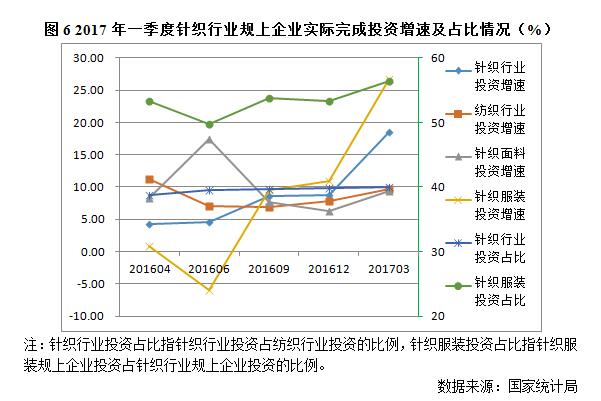
Second, the export situation of the knitting industry in the first quarter
1. Overall situation of import and export
(1) Export aspects
In the first quarter of 2017, the export of knitting industry continued the year-on-year fatigue, with exports of 18.421 billion US dollars (2016 knitting industry's annual export of 98.438 billion US dollars), -9.24% year-on-year, a 4.24 percentage point deeper than the same period last year, unchanged from last year. Annual growth rate. Specifically, the export growth rate of knitted fabrics and knitted garments has been differentiated. The overseas market of knitted fabrics has rebounded significantly, and the export volume has risen. The export in the first quarter was 3.154 billion US dollars (the annual export of knitting industry in 2016 was 11.12 billion US dollars), and the export value increased. From negative to positive, it increased by 8.77% year-on-year, 9.94 percentage points over the same period of last year; the export volume of knitted garments remained low, and the export value continued to decline. The export in the first quarter was 11.393 billion US dollars (the annual export of knitting industry in 2016 was 62.644 billion US dollars), the decline was deepened. To -14.54%, a decrease of 8.52 percentage points compared with the same period of last year. The growth rate of knitted garment export volume continued to be in a negative range, down by 1.25% year-on-year, but increased by 6.11 percentage points compared with the same period of last year. The overseas market of knitted garments also showed a slight increase. The momentum of recovery.
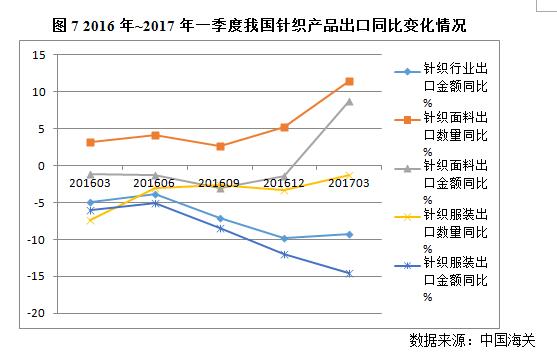
(2) imports
In the first quarter of 2017, the import of knitted products was US$941 million (in 2016, the annual import was US$4.158 billion), an increase of 5.79% year-on-year, and an increase of 6.09 percentage points over the same period last year. Specifically, the import of knitwear from 2016 to 2017 has been maintained. In the first quarter of this year, the import volume of knitwear increased, and the import in the first quarter was 576 million U.S. dollars (the annual import of 2.126 billion U.S. dollars in 2016), an increase of 7.38%. The growth rate increased by 2.91 percentage points compared with the same period of last year. The import volume increased by 18.67% year-on-year. The domestic consumption upgrade brought the driving force for the growth of knitted garment imports. The import of knitted fabrics in the first quarter was basically the same as that of the same period of last year, and the import was 361 million US dollars (2016 year) Imports of 1.701 billion US dollars), the substitution of domestic knitted fabrics has been fully demonstrated.
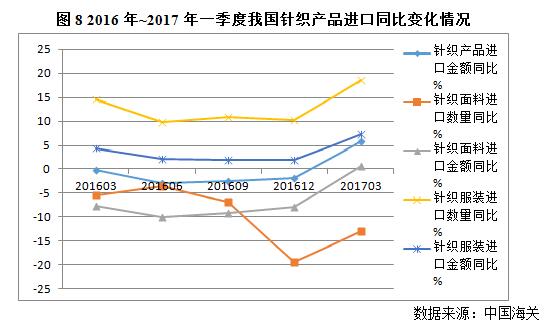
2. Export market situation
The first quarter of 2017 in Europe, the United States, Japan, ASEAN and other major export market for the continuation of negative growth last year, a quarter of China's exports to the US were US $ 2.85 billion (US $ 16.809 billion the year 2016), down 7.04 percent year on year; the EU Exports of 2.957 billion US dollars (16.648 billion US dollars in 2016), down 8.12%; exports to Japan 1.859 billion US dollars (2016 total of 8.189 billion US dollars), down 3.00%; exports to ASEAN 1.925 billion US dollars (2016 full US$9.398 billion), a year-on-year decrease of 7.91%; exports to Hong Kong of US$1.07 billion (2016: US$5.727 billion), down 10.75% year-on-year.
The export growth rate of knitted fabrics is better than that of knitted garments. In the first quarter of ASEAN, the import of knitted fabrics from China was 1.137 billion US dollars (2016: 5.121 billion US dollars), an increase of 7.01%; Hong Kong imported 366 million US dollars of knitted fabrics (2016) In the whole year, it was 6.16 billion US dollars, an increase of 6.21% over the same period of last year, which was 17.89 percentage points higher than that of the same period of last year. Bangladesh, Sri Lanka and Pakistan also had different degrees of growth in imported knitted fabrics from China.
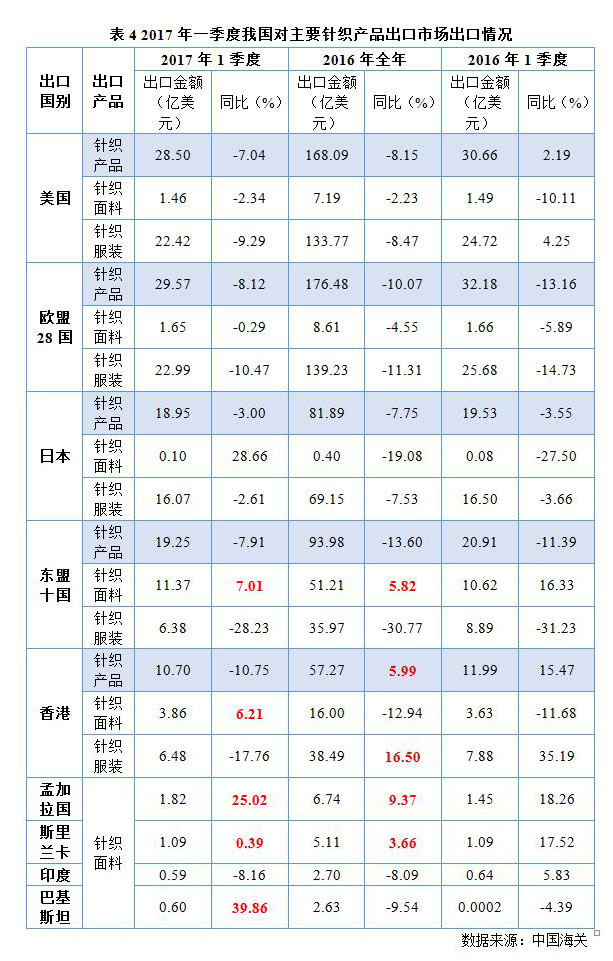
Third, the industry's annual economic forecast
In the first quarter of 2017, the domestic market of the knitting industry led the overseas market to recover, the growth rate of investment in the industry accelerated, the signs of stabilization of the domestic economy were obvious, and the role of domestic consumption upgrades became more apparent. The role of domestic sales in the development of the industry became more and more important. In the first quarter, the overseas market has not changed much. China's exports to countries such as Europe, the United States and Japan have continued to decline. However, the export of knitted fabrics to ASEAN, Bangladesh, Sri Lanka and Pakistan has obviously accelerated, and the transfer of knitted garments has become obvious.
In the first quarter, the social retail data did not change much in the whole year. The better sales data of the company may be related to the replenishment of downstream enterprises. The growth rate of household consumption is limited. In addition, the weakening of the international market and the competition of overseas production capacity, the export situation of the knitting industry is not allowed. Optimistic, the industry's annual growth rate may show a trend of increasing first and then decreasing.
Guangzhou LIDONG Garment Industrial Co., Ltd. , https://www.lidongapparel.com